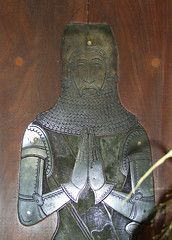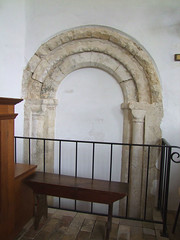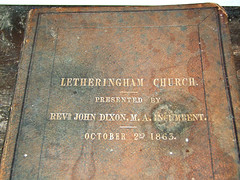| |
|
Although Easton is
only two miles away with its busy village centre and the
Farm Park full of visitors, Letheringham is a place
apart. St Mary can seem more remote than almost any other
Suffolk church, especially on a drowsy summer's day, with
only the bees in the churchyard to break the silence.
There isn't really a village here. The church stands in a
farmyard, and at first appears to have no access. But if
you go down the narrow lane beyond the farm, a track
leads along the edge of the fields, then turns back
towards the farm. Access is through a wicket gate, and
this is where things start to get interesting.
The church is pressed right against the north edge of its
churchyard, and there are several curious ancient
structures nearby. The reason is simple. This is the site
of an Augustinian Priory, and there are substantial
remains of at least one of the outbuildings. The present
church is just a part of the former priory church. The
eastern end fell into decay, and was demolished in the
18th century. The churchyard wall is aligned with the
north wall of the church because it is part of the former
chancel wall.
The east window was rescued from the former chancel, and
no other ruins remain. So St Mary seems unified, and
unlike other churches with lost chancels - Orford, say,
or Great Walsingham in Norfolk. William Dowsing's deputy
Thomas Denny visited on 27th February 1644 but as Trevor
Cooper and John Blatchly note in the 2001 edition of the
Dowsing Journals, he exercised maximum restraint,
removing the prayer clause only from three brass
inscriptions and breaking ten panels of glass. The
monuments in the chancel appear to have been left
untouched, and the contents of the church were well
documented in the late 17th Century by antiquarians. The
church was still in use in 1689 when the brick south
porch was added and dated above the doorway.
However, the church gradually fell into disuse and was
derelict by 1730, and the interior was comprehensively
sacked by 18th Century collectors and vandals. Monuments
and furnishings were ripped out, brass memorials torn up
and sculptures broken off of tombs.
In 1789 the church was restored to use, the ruined
chancel demolished and the nave made good. That this was
before the 19th century Anglican revival explains why the
church doesn't feel particularly Victorian in character.
During the late 20th Century it fell under the care of a
very determined group of people who have ensured its
continual use, and, quite wonderfully, tracked down bits
of the missing monuments and memorials. They have been
returned to the church on permanent loan and are now on
display inside.
Robert Naunton and his two-and-a-half year old son James
retain nothing but the inscription plates to their
memorials, and Robert's is only partial. He died in 1635,
and it tells us that he was somtime Principal
Secretarie and after Maister of the Wards &
Councellor of State to our late King James of happy
memorie, & to our now soverain Lord King Charles.
Of his son who died eleven years before him we learn that
Here lyes the boy whose infancie was such as promis'd
more then's parents durst desire, yea frighted them by
promising to much for earth to harbour long'.
Another inscription tells us that Favour is
Deceitful, and Beauty is Vain, but a Woman that Feareth
the Lord, she shall be Praised, which probably
played better in the early 18th Century than it would
now. The north doorway which led into the Priory
cloisters is now filled in, and all the furnishings are
of necessity modern, but still, there is a quiet
loveliness here, and the happy lion on the royal arms
seems well-pleased with it all.
Coming back onto the road to Hoo, the true situation of
the building on the edge of the farmyard can be seen, the
former priory gatehouse looking out across the fields.
Beyond, a walled area surrounds the grounds of
Letheringham Hall, which was demolished in the 20th
Century. A boiling of elder trees at the top of the hill
shows its former location. Passing this way in the first
few days of 2020 I was excited to see two sparrowhawks in
battle over the tower, oblivious of me watching.
This is not Suffolk's most beautiful church, or its most
interesting. But I think it is lovely, and valuable, and
it has one of the best settings in the county. It doesn't
take much imagination to see how the dissolved priory
could have become a farm, and the priory church, like
many others, allowed to become ruined. But it was saved,
and that is an accident of history. That so much love has
been lavished on it since, is a sign of hope.
Simon
Knott, January 2020
Follow these journeys as they happen at Last Of England
Twitter.
 
   
   
  
Amazon commission helps cover the running
costs of this site
|
|
|

